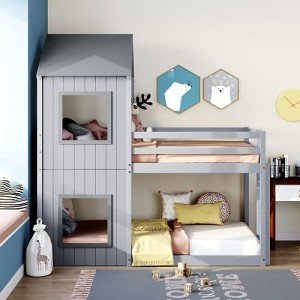
Adult Bunk Beds
Add a review FollowOverview
-
Founded Date July 10, 1941
-
Sectors Education & Training
-
Posted Jobs 0
-
Viewed 16
Company Description
20 Fun Informational Facts About Bunk Beds
Exploring Bunk Beds: A Comprehensive Guide
Bunk beds have long been a staple in kids bunk beds‘s bed rooms, dormitories, and even homes with restricted space. Not only do they supply a practical sleeping option, however they likewise produce an enjoyable and creative environment for kids bunk bed and a great space-saver for adults and families. This article will explore everything you need to understand about bunk beds, from types and materials to safety tips and buying recommendations.
Tabulation
- Kinds Of Bunk Beds
- Traditional Bunk Beds
- Loft Beds
- Triple Bunk Beds
- L-Shaped Bunk Beds
- Material Options
- Wood
- Metal
- Safety Considerations
- Buying Guide
- Frequently asked questions
Kinds Of Bunk Beds
Bunk beds are available in numerous designs to match various needs and preferences. Here’s a breakdown of the most common types:
Conventional Bunk Beds
Standard bunks typically feature two beds stacked vertically on top of one another. These beds are perfect for siblings sharing a space or for optimizing sleeping space in visitor spaces.
Loft Beds
Loft beds stand likewise to standard bunk beds but do not have a lower sleeping location. Instead, they typically include a desk or seating area beneath, making them a great option for little rooms requiring multifunctionality.
Triple Bunk Beds
Triple bunk beds are created for three residents, with beds stacked in a three-tier setup. These are less typical however can be an enjoyable service for large households or slumber parties.

L-Shaped Bunk Beds
With one bed positioned horizontally and the other vertically, L-shaped bunk beds are often equipped with extra features such as desks or storage drawers and can complement corner areas in a space.
Contrast of Bunk Bed Types
| Bed Type | Perfect Use | Description |
|---|---|---|
| Standard | Shared bed rooms or visitor spaces | 2 beds stacked vertically |
| Loft | Small rooms requiring multi-purpose space | Upper bed with open space below |
| Triple | Large families or pajama parties | 3 beds stacked vertically |
| L-Shaped | Corner or versatile spaces | A combination of vertical and horizontal beds |
Product Options
Bunk beds are manufactured from various materials, with wood and metal being the most common. Each material has its benefits and drawbacks.
Wood
- Sturdiness: Generally robust and can withstand years of use.
- Visual Appeal: Offers a traditional appearance that can mix with different decorations.
- Weight Capacity: Typically sturdier; can support much heavier weights.
- Downsides: May be more pricey than metal alternatives and can be susceptible to scratches.
Metal
- Durability: Generally light-weight and easy to move but still durable.
- Modern Design: Often comes in smooth styles, making it appealing for contemporary spaces.
- Cost-Effective: Usually more economical than wood choices.
- Disadvantages: Can be cold to the touch in winter seasons and may not have the same aesthetic appeal for some buyers.
Security Considerations
When it pertains to bunk beds, safety can not be neglected. Here are key safety pointers to keep in mind:
- Guardrails: Ensure that the leading best rated bunk beds has guardrails on both sides to prevent falls.
- Strong Construction: Check for a strong build and strong materials to stand up to weight and movement.
- Weight Limit: Adhere to the producer’s weight limit for both the upper and lower bunks.
- Ladder Design: Choose bunks with a safe, easy-to-climb ladder and avoid any sharp edges or rungs.
- Age Restrictions: Most makers advise that children under the age of 6 ought to not sleep in the upper bunk beds for adults uk.
Purchasing Guide
When shopping for bunk beds, think about the list below aspects to find the best rated bunk beds suitable for your needs:
- Space Availability: Measure the room size and ceiling height, ensuring there is appropriate space for the top bunk.
- Bed Size: Decide between twin, full, or bigger sizes based on your needs and the size of the space.
- Design Preference: Consider the overall decoration of the bedroom to discover an appropriate design.
- Reduce of Setup: Look for a bunk bed that is simple to assemble.
- Budget plan: Bunk beds can be found in different rate ranges, so figure out a budget before starting your search.
Frequently asked questions
1. What is the recommended age for kids to sleep on the leading bunk?
Children aged six and older are typically advised to sleep on the top bunk to lessen the risk of falls.
2. How can I make my bunk bed much safer?
To enhance security, guarantee guardrails are effectively set up and examine that the bed is placed on a flat surface. In addition, encourage kids to use the ladder thoroughly.
3. Can I convert a bunk bed into 2 separate beds?
Lots of bunk beds are created to be convertible. Examine the producer’s specifications for convertibility functions.
4. What devices are offered for bunk beds?
Typical accessories consist of bed linens, storage drawers, staircases instead of ladders, and tented canopies for an enjoyable visual appeal.
5. How do I keep my bunk bed?
Regular look for loose screws or structural stability can help make sure safety. Dust the bed regularly and tidy spills promptly to keep the products in good condition.
Bunk beds are versatile and a space-efficient solution for numerous living situations, from kids bunk beds‘s spaces to guest lodgings. With numerous styles and materials available, prospective buyers have a wealth of options to consider, guaranteeing a mix of usefulness and visual appeals. By focusing on safety and following the suggestions outlined in this guide, people can discover the ideal bunk bed that suits their space and way of life, all while producing a satisfying sleeping environment.
